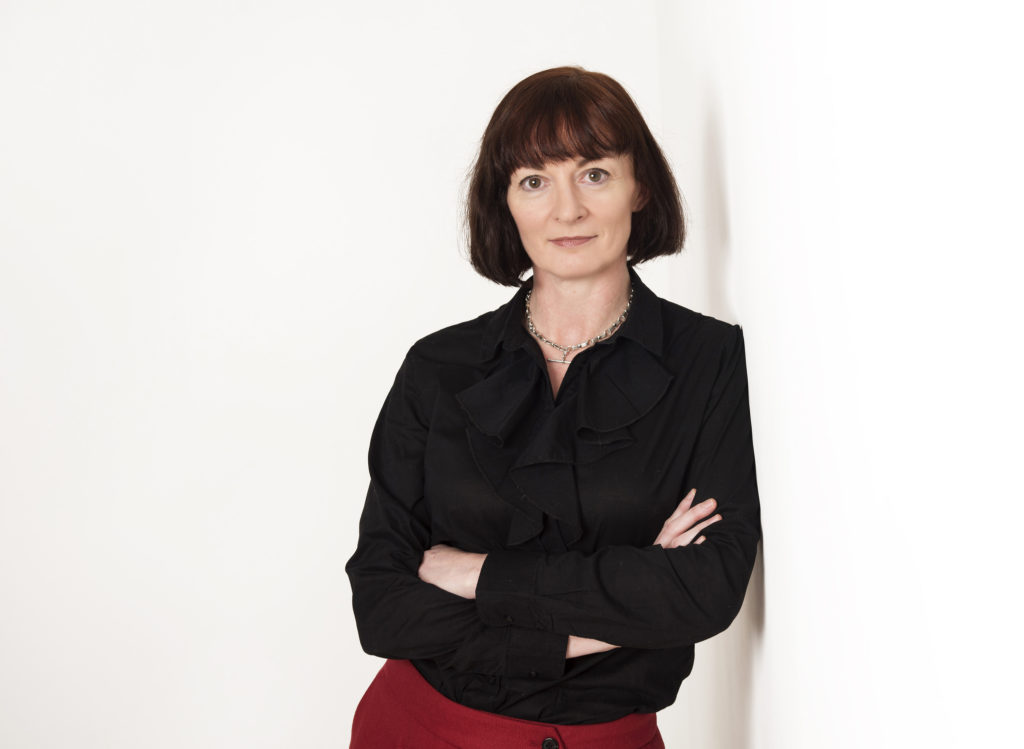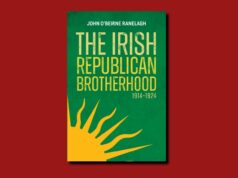Interview by Mary McCarthy, April 2020

“I am quite a reclusive person but I wanted to write with open eyes and I am not naive. I know my work is outside of the easy book-club fare but I wanted to remain true to what I saw in life.”
We all have an outline of a life story set out for us—we may stick to the path or we can break the mould—and everything about Cathy Sweeney’s short-story collection smacks of deciding not to play ball and roll along with neat expectations.
Cathy started to write in her late 30s, an age when most of us realise life is messy, and perhaps this accounts for the lack of sentimentality in her work—the delivery is taut and deadpan, often funny despite sombre themes.
After more than twenty years teaching English at second level, last autumn Cathy gave this up to concentrate full time on writing.
Previously, she often attracted glowing praise from other notable writers and had many stories published in The Stinging Fly and The Dublin Review.
Cathy’s writing came from a habit of reading and her techniques are skilful—the reader is immediately dropped into her stories, even if they have no idea where they are, and her distilled descriptions are incredibly evocative.

If I could describe Modern Times in two words I would choose unconventional and intriguing. All the stories are short, one is only 111 words, the longest is nine pages—perfect pandemic material if you can’t settle on long reads—these stories jolt the mind alright.
Like Carver, all the fat is trimmed off. Unlike Carver, whose stories have their dial firmly switched to realism, Cathy uses surrealism to highlight the subconscious mind; in one story people are starting to turn blue—possibly climate change or possibly because everyone is lying to themselves or unhappy? I suspect there is no one answer.
When I told Cathy her story ‘The Chair’—about a married couple that take it in turns to torture each other—had produced many different theories when discussed at a book club she was delighted; she had intended for the reader to interpret a meaning through their own prism of experience and state of mind.
There is an absence of self-delusion—a narrator’s tone is often jaded. One of her characters ‘like most people started out in life hopeful and hardworking, but one misstep leads to another’ and another gets ‘mired in the unhappiness that makes people put on weight and watch too much TV’.
One central theme jumps out from this collection—sex. There is sobering sex in nearly every story and transgressive sex in many. The desire is often undesirable—there are fantasies and needs that surge along. A woman buys her husband a sex doll for his 57th birthday and, as a result, he loses weight and buys his wife flowers—not your usual romantic fare. A lonely, immature teacher has sex with one of her students, a boy with special needs.
Everyday details are threaded throughout, which jar with a strange world where a baby can be kept in a freezer while a mother goes out to work, or where a new father in a slump surrounds himself with rotting oranges.
This collection is a pleasure to read and there are wise lines dotted throughout—it manages to be both meaningless and meaningful; the reader will decide what to take from it. This sounds like complete nonsense but if you read Modern Times you will see what I mean.
Cathy has a fresh, innovative style and it will be interesting to see this expand in the novel she is working on.
Why is there so much so much sex in Modern Times?
I think desire is essential to how we maintain vitality, it is kind of elemental. What we are doing with it—expressing it or repressing it—there is an unspoken undercurrent there that affects every aspect of our lives.
I do often observe women telling me one thing with their mouths and another story with their eyes. ‘White’ was my first published short story, which is about a woman raging about the life she finds herself in and seeing there is no way out, which drives her to take drastic action. The untameable nature of desire—it is the oldest story in the book, of course. It’s a reductive attitude that you meet someone you love and then that’s that. Desire is a beast that stalks people all the way through. People meet others they are attracted to and these feelings are often unwanted. We associate sex with money and the beauty of youth but there are more desiring people outside the margins that are not young or beautiful. Without desire you can be like the living dead.
Did you always want to be a writer?
I did not start writing until my late 30s. I had always been an avid reader; as a teenager I remember I would get almost violent if called away from my book. My relationship with the story broke down a bit as I got older. I saw how in real life we lived inside stories like they had edges. That is so seductive, to believe life will always work out. Like everyone, a lot of things happened to me over the years—and I felt I wanted to write stories that were not so straightforward. I am quite a reclusive person but I wanted to write with open eyes and I am not naive. I know my work is outside of the easy book-club fare but I wanted to remain true to what I saw in life.
Did you enjoy teaching?
I was a teacher right up until last year and I loved it with a passion. It was quite consuming for me. Alas, teaching never ends well, as Freud said. Towards the end I did not feel as enthused. I felt I was winding myself up to perform. Intrinsically, I was enthusiastic about writing and wanted to do more. With the teaching, I was maybe wanting too much. I am not 25, 35 or even 43 anymore and I knew it was something I was finished with. I am perhaps open to other forms of teaching but I am finished with secondary level.
Were you nervous giving this up?
I tend not to have a huge amount of ability to do things that don’t feel right. I’m OK moving into a void. When I left teaching I had no idea Modern Times was to be published in the UK. There was not one step to another. I don’t buy the whole career stages idea, the myth of progress.
How is lockdown going?
I am amazed people are still quite competitive in lockdown, as I would have thought it would have subdued most. I am crap at it and have been accepting to sit in my PJs in a pool of stasis. I enjoy going out and about—to bookshops, coffee shops. I’m not good at baking bread, I can’t talk on screens—it’s a bit lonely. I am a bit lost and not good at it. Reading concentration is not great. So I have settled into listening to a lot of nineteenth-century fiction on BBC Radio 4 Extra (Persuasion, Anna Karenina, The Age of Innocence).
Half of your short stories are narrated by men—was this a decision?
Incredibly, there are so many great female narratives written by men—Madame Bovary, Lady Macbeth, Molly Bloom—but there are few male characters written by women. Yet, I did not set out to do this. The stories came to me from a male point of view.
Do you read your reviews?
I do read reviews—of course I do! Someone has sat down to read my work so it’s interesting for me to know what they thought of it. I don’t have huge tentacles into the publishing world so I do not have that much contact. You put the work out there and then just wait. It is a strange feeling because it is not like many people contact you to tell you what they think. I did get one dream review in The Irish Times but then there was another one that I read with a lump in my throat. I tell myself of course my work is not going to be palatable to everyone.
What are your literary influences?
They are very wide. Modern Times is a very slim book. Lots of reading and thinking went into creating it. I decided to get straight to it—there is no extra padding. I love Chekhov, Tolstoy—Russian short stories are a big draw for me. The Penguin Book of Russian Short Stories is a good place to start. I admire voices not afraid of brutality, and ones that can strip back all life’s falseness—that is very compelling. I have yet to read Enda O’Brien’s new novel [Girl, which is about Nigeria’s abducted schoolgirls]; she is not afraid to tackle a very brutal world. Anne Enright, Claire Keegan, Annie Ernaux and Susanna Moore are among the many authors I admire.
Your daughter is a writer. Do you discuss techniques?
Lucy [Sweeney Byrne—recently published Paris Syndrome with Banshee Press] is completely different to me in terms of practice. Not much done for her is 4,000 words, whereas for me it could be two lines. There is a generational difference in that, perhaps. Lucky for her, she was grown up when I started writing so she grew up with a teacher, not a writer, as a parent. I started English at Trinity and she did the same. We don’t talk much about writing but we talk about books non-stop.
Children and adolescents feature strongly in Modern Times. Why is this?
Children have always been part of my life. I had my first child when I was 18 studying English in Trinity and my youngest child turned 18 last November. I have always enjoyed the fun of children but being a parent is not always fun. When I was studying I was aware of the incredible luxury of it. I loved the absorption. The only real difference between me and other students was that I never went away for the summers—that was all I felt I missed out on.
I then went on to take my HDip. and began teaching. It took me years to stop missing university; I was bereft of the intellectual stimulus. When I started writing it was natural for me to include children and adolescents in my work in a complex way. I believe that every writer should be completely free to explore whatever subject matter they want to, no matter how uncomfortable; it up to readers to decide whether or not they want to engage with the work. The purpose of art is to reflect life, in all its horror and beauty.
Describe your average writing day.
Like most writers, I try to get a few hours at the desk each morning, but my ideal method of work is to drift with no fixed plan. Going to the library, sitting in cafes, going to bookshops and just observing. Ideas come to me when I am out and about—it was while shopping in Marks & Spencer in Blackrock and I was struck with how vibrant all the different types of oranges there were that the idea came to write a story about a man overwhelmed by doubt when he becomes a father—in a way new babies can make people more aware of their own mortality.
What are you currently working on?
I am working on a novel in which a woman goes on a two-day road trip and ends up in a completely different life. Before the current crisis I was pretty much method writing—going on the journey the woman goes on, feeling everything through her eyes. In lockdown I am still working but at a much slower pace.
Can creative writing be taught?
Yes, I think so. But voice is a whole other thing. And courage.
Modern Times is available from The Stinging Fly Press and bookshops now.

Mary McCarthy: This Literary Life
Mary McCarthy is a freelance journalist writing for a number of publications. She is an avid reader and an iron-willed book club administrator.
@maryknowsbees












